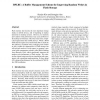Free Online Productivity Tools
i2Speak
i2Symbol
i2OCR
iTex2Img
iWeb2Print
iWeb2Shot
i2Type
iPdf2Split
iPdf2Merge
i2Bopomofo
i2Arabic
i2Style
i2Image
i2PDF
iLatex2Rtf
Sci2ools
FAST
2008
2008
BPLRU: A Buffer Management Scheme for Improving Random Writes in Flash Storage
Flash memory has become the most important storage media in mobile devices, and is beginning to replace hard disks in desktop systems. However, its relatively poor random write performance may cause problems in the desktop environment, which has much more complicated requirements than mobile devices. While a RAM buffer has been quite successful in hard disks to mask the low efficiency of random writes, managing such a buffer to fully exploit the characteristics of flash storage has still not been resolved. In this paper, we propose a new write buffer management scheme called Block Padding Least Recently Used, which significantly improves the random write performance of flash storage. We evaluate the scheme using trace-driven simulations and experiments with a prototype implementation. It shows about 44% enhanced performance for the workload of MS Office 2003 installation.
| Added | 02 Oct 2010 |
| Updated | 02 Oct 2010 |
| Type | Conference |
| Year | 2008 |
| Where | FAST |
| Authors | Hyojun Kim, Seongjun Ahn |
Comments (0)

